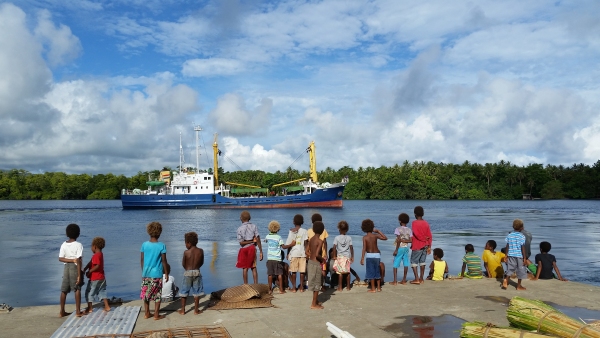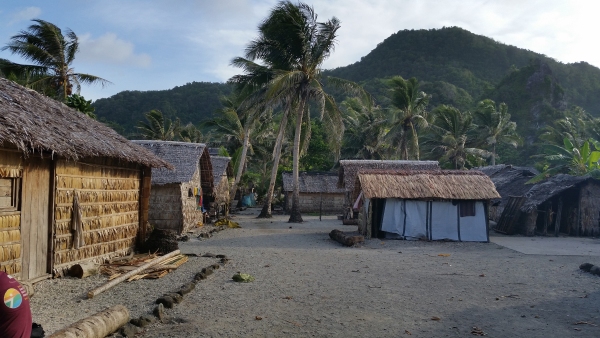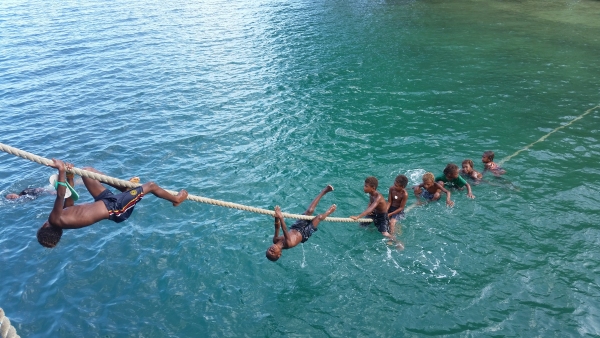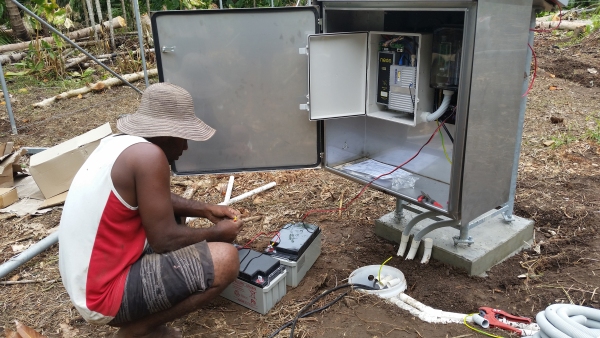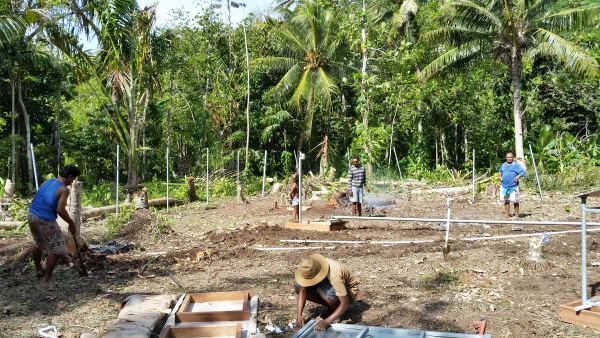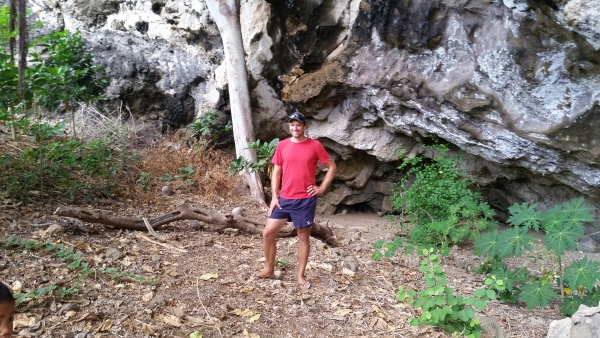A NIWA technician spends four days and three nights on a crowded boat heading to one of the most remote places in the Pacific to help install a weather station. Conditions are so arduous he decides to quit his job - but how do you do that in the middle of the ocean? By Susan Pepperell.
It wasn’t until he was walking to the wharf that Jeremy Rutherford started to think about what he should expect for the next few days.
The irregular monthly voyage from Honiara to remote Tikopia – a dot in the ocean 1017km from the Solomon Islands capital – had been cancelled so it was either abandon his mission or charter a ship. He chose the latter.
In many ways, it was a great solution. Jeremy, an environmental technician for NIWA, Barnabas Tahunipue, chief technical officer for the Solomon Islands Meteorological Service and Eric Houma, project leader for the United Nations Development Programme, were suddenly in the unusual position of being in charge of their own destiny.
For if you spend any time in the Pacific, the one thing you learn is that simple tasks take a long time, delays are normal and often everything is beyond your control. If you’re a methodical control freak like Jeremy, you need to learn to get over yourself.
Jeremy, Barnabas, Eric and a team of six people from the Solomon Islands Meteorological Service were heading to Tikopia to install an automatic weather station, a huge technological leap forward that would provide vital information to help enable Solomon Islanders adapt their way of life as the climate changes.
Today – a year on – Jeremy still can’t think about that voyage with a great deal of fondness. He can laugh about it, briefly, but when he looks at photographs he shudders at the memories.
The journey begins
The first part was easy. He flew 660km to Lata, which is as far as the planes fly, and met the ship there. Google Lata and it will tell you it is a “very small place” in the Santa Cruz Islands, population 553.
They stayed the night and set off before 6am to prepare for an early departure.
“Walking to the wharf I saw people and equipment everywhere. Word had got out that a ship was operating after all, so every man, woman, child and their livestock had turned up for the ride.
“Every single, tiny nook and cranny of that ship was packed with people, food, freight, sacks, furniture, chickens - anything you can think of, it was there.”
By the time Jeremy arrived, there were already about 300 people on board. And one toilet.
The cargo hold was full. A platform lowered over the top was crammed with people, and a small internal area, which had been stripped of fittings, was also full. Jeremy pushed his way through and out onto a deck at the back.
“There was a rail to lean on and that was all we got. No shelter, nowhere to even sit. To be honest it was a real kick in the guts for me. I didn’t expect comfort but I did expect somewhere to sit down.
“Then it started to rain.”
At this point Jeremy decided to quit his job, and fired off a few colourfully worded texts to colleagues back in Christchurch informing them exactly where they could lodge his employment. But quitting is one thing; standing on the back of a boat in the rain heading to one of the most remote places in the Pacific was the reality.
The ship headed around the Santa Cruz islands, mooring at different spots along the way. People got off, other people got on.
They headed on to the Reef Islands and spent the night there. Jeremy slept on a coconut leaf mat on the sand in the home of a local befriended on the ship. There was no running water and it was hot. Low 30s, extreme humidity. Everything was sticky and grimy.
Then it was on to the Duff Islands. Space was freeing up on the boat, although the internal area was still full. People fished off the back. They stayed in a village overnight which boasted the luxury of a tap. “You lined up and waited for your turn to have a shower – it was so good.”
The next leg of the voyage to Tikopia took the rest of the afternoon and all night.
“I was still pretty dark but much better. I had stopped fighting it and I was not going to leave my job anymore but I wasn’t happy.”
****
Tikopia
Tikopia is so small, maps assist its location by having big arrows on them pointing to a pinhead in the middle of nowhere. The island covers five square kilometres, is home to about 1200 people spread across 20 villages, and known for being more Polynesian than Melanesian.
It is also vulnerable – and changing. Climate scientists expect the Pacific region to experience more extreme rain events, higher temperatures and higher sea levels as the climate changes. Ocean acidification is expected to adversely affect corals, the variety of marine species may decline and some fish species may migrate, all of which affects the livelihoods and security of the communities living there.
At a community meeting on Tikopia, Jeremy, Barnabas and Eric explained what the weather station would do, how it would collect data that would feed into other data collected around the Solomons and across the Pacific to help understand how the climate is changing, and how it would help authorities respond more quickly in the aftermath of severe weather events, such as Cyclone Zoe which decimated Tikopia in December 2002. .
And they found locals intensely interested in the issue, keen to learn and to understand how the station would benefit their way of life and enable them to become more resilient to climate changes.
“They want to preserve what they have but are open-minded enough as a society to know they have to adapt.”
NIWA has a long association with the Pacific and has carried out similar work in a number of countries, often with the same reaction from locals. Behind each project is a common aim: to empower local staff and enable them to develop their capacity to maintain the technology and use the data being collected to make informed decisions.
Met officers from the Solomons spent two weeks in New Zealand ahead of the installations learning how to assemble the stations and how they worked. This was followed up by on-the-job training as the stations were installed and commissioned with a buddy system in place to provide remote ongoing support.
Getting the weather stations to the Solomons
Logistically, getting a weather station to the Solomons is a complex undertaking. The UNDP programme, which NIWA was contracted to carry out, required establishing six electronic weather stations and 12 standalone rainfall stations at strategic sites, more often than not in remote areas.
Everything must be shipped from Christchurch weeks in advance. That includes instruments, the structure, the mast, the pipework and the fencing. A rigorous process Jeremy calls “check, check, check and check again” is adhered to.
NIWA staff undergo cultural training in New Zealand that provides an insight into customs, traditions and behaviour. Things like always accepting an invitation to someone’s home for a meal and being expected to eat first.
Malaria is also rampant, dengue fever common. Jeremy carries a full medical kit – “basically everything you can self-administer I take with me”. Any emergency would involve a week-long trip home. There is no internet, no international cell phone coverage but a brief daily check-in is maintained via satellite phone.
Delays are the only certainty.
“They just compound so quickly – if equipment is a day late it might be three days before the next flight so you’ve just got to wait. That happens quite often.”
Then there is the process of securing the land on which the station is to be built. Land ownership is complex in the Solomons and there are few records. Claims and counterclaims can blindside negotiations.
But the strong sense of community means there are always people who will help. UNDP pays for people to carry the gear to the installation site, and also employs several locals to assist with the building.
“As soon as we would start people would turn up to help; they’d dig a hole, clear bush or do whatever was needed. It was fantastic and made the job a lot easier.”
A special visitor
On their fourth and last night they hosted Tikopia’s chief at a banquet and ate turtle which are in plentiful supply.
“It was delicious.”
But the protocols of the chief’s visit were daunting. Only speak to him if he speaks to you, only drink what he decides he wants to drink, and eat whatever he offers you from his plate. Above all, approach him on your knees and walk backwards to leave.
“We were all pretty scared for a while, then everyone started to relax and we found we could just talk to him like anybody else.”
They sang a local version of what Jeremy recognised as the Maori Kamate haka and he found himself joining in.
He left the next day, but not before visiting a location where the community had dammed a channel that had been created during Cyclone Zoe causing a breach through the land between the ocean and the crater lagoon. Advice on repairing the breach had been provided by NIWA’s Pacific Rim manager Doug Ramsay following the cyclone. The filled breach protects the freshwater crater lake from the saline ocean water and provides an important source of fish, ability to grow swamp taro, and secures a vital source of water.
Homeward bound
The voyage back was almost as uncomfortable as the one over, and this time shared by pigs in cages. The ship ran aground for a time on the Reef Islands. By the time they reached the island of which Lata is the main town, they’d had enough and jumped ship. Somehow a small boat with an outboard was arranged to take them around the coast to the road’s end where a truck was waiting to take them on a 90-minute bone-crushing ride back to Lata.
But for all that, Jeremy can still call it “an amazing experience”.
“There were so many highs and so many lows. I came away from that trip really thinking how much Western society had to learn from them.
“Everyone is the same, there is no trying to keep up with anyone else but they have everything they need and no one wants for anything else.”
And with time, the hardships have been largely forgotten. So much so that he’s going back in March as part of NIWA’s ongoing commitment of support to the Solomons.
“Someone has to go and currently it’s me. I’m not joyous about it but I’m comfortable. I know not to have any expectations other than the worst.”
He’s also going to buy a chair for the boat trip.

